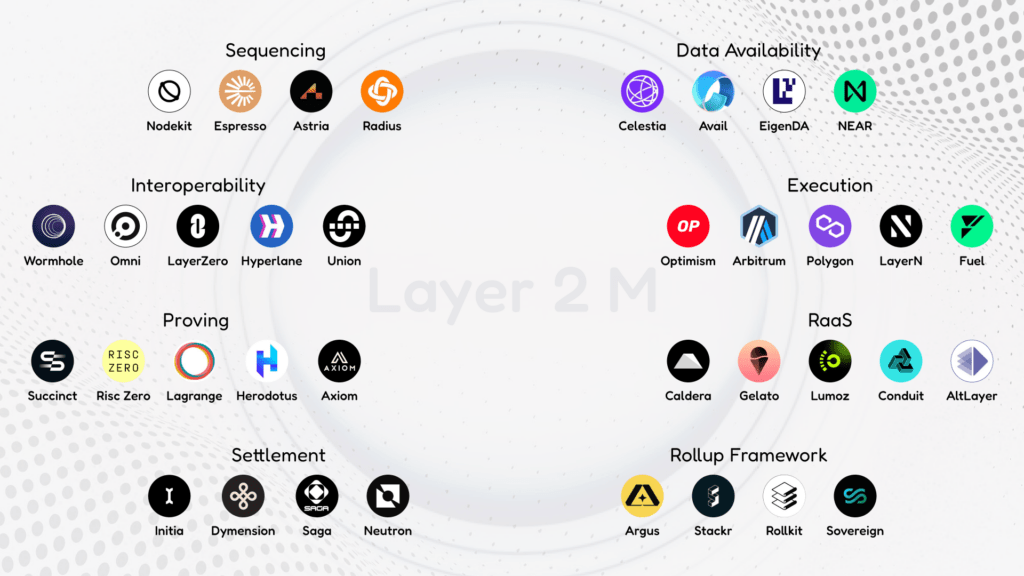Research Summary
The report discusses the evolution of cross-chain messaging protocols in the blockchain ecosystem, focusing on the challenges of interoperability and the shift from first-generation bridges to more secure, second-generation solutions. It highlights the growth and performance of key projects such as Chainlink’s Cross-Chain Interoperability Protocol (CCIP), LayerZero, Axelar, and Wormhole. The report also explores the potential of these protocols in connecting traditional finance with real-world assets and the future of cross-chain communication in a multichain ecosystem.
Key Takeaways
Evolution of Cross-Chain Messaging Protocols
- Shift from First-Generation Bridges: The report highlights the evolution of cross-chain messaging protocols from first-generation bridges, which have faced over $2B in losses from security breaches. The industry is moving towards more secure, second-generation cross-chain messaging protocols that support native integration and facilitate the exchange of not only tokens but also arbitrary data.
- Performance Metrics: The shift in cross-chain messaging protocols has also led to a change in performance criteria. Total value locked (TVL) is no longer the primary metric; instead, transaction- and message-based metrics are now more relevant. The report emphasizes the significant growth in transaction counts for projects like Axelar and LayerZero.
- Expanding Ecosystem: The cross-chain messaging ecosystem now supports over 60 chains and has seen over 900% year-over-year growth in aggregate transaction count. This growth indicates a broader confidence in cross-chain messaging protocols and their role in the multichain future.
- Key Projects: The report provides detailed insights into key projects such as Chainlink’s CCIP, LayerZero, Axelar, and Wormhole. These projects have shown significant growth and adoption, with unique features and security measures that set them apart in the cross-chain messaging space.
Role of Cross-Chain Messaging Protocols in Traditional Finance
- Connecting Traditional Finance with Real-World Assets: Cross-chain messaging protocols have the potential to bridge traditional finance (TradFi) with real-world assets. Chainlink’s CCIP, for example, has a strong focus on security and stands to benefit from Chainlink’s established presence to bootstrap initial growth, particularly in connecting TradFi with real-world assets.
- Tokenization and TradFi Adoption: The progression toward tokenization and TradFi adoption may further catalyze the usage of cross-chain messaging protocols. The report highlights the recent collaboration between Onyx by J.P. Morgan and Apollo Asset Management as an example of cross-chain messaging protocols’ role in cross-chain portfolio management using on-chain tokenized funds and smart contracts.
Future of Cross-Chain Communication
- Multichain Ecosystem: The report emphasizes the importance of effective cross-chain messaging as we move towards a multichain ecosystem. Protocols such as Chainlink CCIP, LayerZero, Axelar, and Wormhole are rising to meet the demand for cross-chain communication.
- Key Differentiating Factors: Differentiating factors among these protocols include the number of supported networks, decentralization, security, scalability, integration costs, and ecosystem partnerships. These factors are crucial in evaluating cross-chain messaging protocols.
- Composable Application Development: Cross-chain messaging solutions lay the groundwork for the future of composable application development. They enable the exchange of arbitrary data across distinct networks, unlocking cross-chain execution and new use cases.
Actionable Insights
- Understanding the Evolution of Cross-Chain Messaging Protocols: Stakeholders in the blockchain ecosystem should familiarize themselves with the evolution of cross-chain messaging protocols. Understanding the shift from first-generation bridges to more secure, second-generation solutions can help in making informed decisions about blockchain development and investment.
- Monitoring Performance Metrics: It’s crucial to monitor transaction- and message-based metrics, as they have become more relevant measures for assessing the effectiveness of cross-chain messaging protocols. This can provide insights into the performance and adoption of these protocols.
- Exploring Key Projects: Stakeholders should explore key projects such as Chainlink’s CCIP, LayerZero, Axelar, and Wormhole. Understanding their unique features, security measures, and growth trajectories can provide valuable insights into the cross-chain messaging space.
- Assessing the Role of Cross-Chain Messaging in Traditional Finance: Stakeholders should assess the potential of cross-chain messaging protocols in connecting traditional finance with real-world assets. This can help in identifying opportunities for collaboration and integration in the financial sector.
- Preparing for the Multichain Future: As the blockchain ecosystem moves towards a multichain future, stakeholders should prepare for the increasing importance of effective cross-chain messaging. Understanding the key differentiating factors among various protocols can guide strategic decisions in blockchain development and investment.













